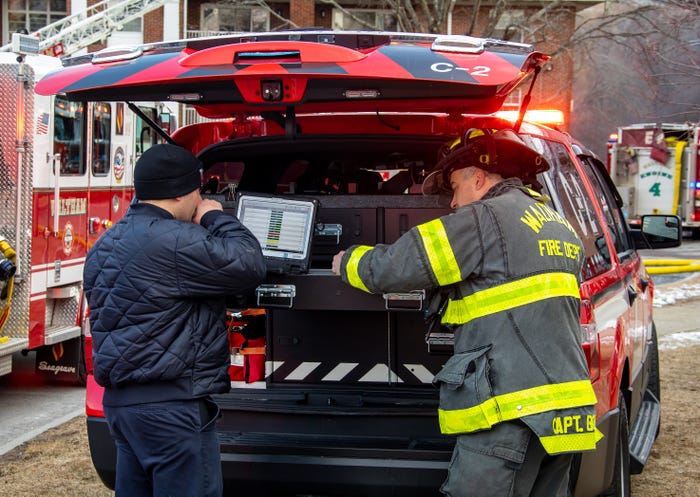Danger: High voltageDanger: High voltage
August 1, 2003
When a transmission line is terminated by an impedance other than a purely resistive impedance equal to the characteristic impedance of the line, standing waves exist on the line. When a high voltage standing wave ratio (VSWR) exists on a transmission line there are points of voltage maxima (antinodes) and voltage minima (nodes) — the greater the mismatch or VSWR, the greater the peak voltage on the line. If the voltage at the peaks or maxima becomes high enough, punch-through can occur. Punch-through is the point at which the voltage between the inner conductor and the shield (outer conductor) exceeds the voltage rating of the dielectric material or insulation of the center conductor.
It is important to know the characteristics of the transmission line and to be able to calculate the peak voltage that can be expected on the line for a given VSWR or load mismatch condition. Furthermore, if the reactive and resistive parts of the load impedance are known, it is possible to calculate the exact location on the line where the peak voltage will occur. It is important to remember that any reactive load will produce standing waves on the line.
Quantifying the mismatch
Many units of measure are used to define or quantify the degree of mismatch on a line. Reflection coefficient, SWR, return loss, and reflected power (in percentage) are used to quantify the degree of mismatch on the transmission line. Typically, the land mobile radio technician uses a directional wattmeter connected in the transmission line to measure the forward and reflected power. If the load impedance perfectly matches the transmission line impedance, the reflected power is zero. If the load impedance is not equal to the transmission line impedance, the wattmeter will indicate the amount of reflected power. The net power is equal to the difference between the forward power and the reflected power. The net power is the amount of power that is dissipated or radiated — usually a combination of both, since line losses are incurred in any practical transmission line.
Suppose that the setup shown in Figure 1 indicates a forward power of 100W and a reflected power of 25W. Assume for the moment that the transmission line loss is zero. In this case, the forward power at the load (antenna) is 100W and the reflected power at the antenna is 25W. In terms of percentage, the reflected power is 25 percent at the antenna and the transmitter. The VSWR is the same at all points on the line.
Reflection coefficient can be anything from zero to one, with zero representing a perfect match and one representing the worst-case mismatch. If the forward and reflected power is known the reflection coefficient can be found from the formula below, where Г (gamma) represents the reflection coefficient and r is the reflected-to-forward power ratio.
In the case above where the forward power was 100W and the reflected power was 25W, the reflected-to-forward power ratio, r, is 0.25. Plugging this into the formula above yields:
The reflection coefficient can also be calculated from the SWR. The formula is shown below, where S represents SWR and G is reflection coefficient.
If the SWR is 3, plugging this into the equation yields:
Using the same forward and reflected power we can calculate the SWR from the formula below, where S is SWR and r is reflected-to-forward power ratio.
The SWR can also be calculated directly from the reflection coefficient as shown in the following formula.
The return loss can be calculated from the reflected-to-forward power ratio from the formula below, where LR is return loss in decibels and r is the reflected-to-forward power ratio.
In terms of SWR, the return loss (LR) can be calculated as shown below, where S represents SWR.
In terms of reflection coefficient (Г), the return loss (LR) can be calculated as shown in the following formula.
Figure 2 shows the current and voltage phasors for the mismatch condition discussed so far, where the forward power is 100W and the reflected power is 25W. Here, the voltage is normalized to 1 and the maximum voltage will occur when the voltage of the reflected wave is in phase with the voltage of the forward wave. The phasors representing the forward and reflected voltages rotate in opposite directions. At one point, the phasors are in phase. This produces a point of maximum voltage on the line. At another point, the phasors are 180° out of phase. This produces a point of minimum voltage on the line.
Notice, too, that when the voltage phasors combine in phase to produce a maximum voltage the current phasors are 180° out of phase, producing a point of minimum current. Therefore, this is a high impedance point on the transmission line. The normalized voltage ratio at the point of maximum voltage is equal to the reflection coefficient plus one (1 + Г).
The maximum voltage on the line can be found by multiplying the voltage in the forward wave by the sum of 1 + Г or 1.5. The voltage in the forward wave can be calculated from the formula below, where E is the rms voltage, Z is the system impedance and P is the power in the forward wave.
With a forward power of 100W the voltage in the forward wave is 70.7V. With the reflection coefficient of 0.5, the maximum rms voltage on the line will be 1.5 × 70.7 or 106 volts rms. The peak voltage is 1.414 × 106 or 150 volts.
Also, the maximum rms voltage on the line can be calculated from the following formula, where S is SWR, P is net power and Z is system impedance.
For example, the net power is equal to forward power (100W) minus the reflected power (25W) or 75W. Substituting this figure and an SWR of 3 into the formula yields
Again, the peak voltage can be found by multiplying the maximum rms voltage by 1.414.
Let’s look at a couple of examples of coaxial cable with high VSWR. Suppose a piece of RG58 with foam dielectric is connected to a transmitter that has a power output of 500W. This cable can handle a maximum rms voltage of 600 volts. If the cable is connected to a perfectly matched load impedance, the normal rms RF voltage on the cable is found as shown below.
This is well within the capability of the cable. Now, suppose the load is mismatched resulting in a VSWR of 3:1 at the transmitter. Remember, if we use the VSWR to determine the maximum voltage we must calculate the net power (forward minus reflected). For a VSWR of 3:1 the net power is 375W. The rms voltage on the line is now:
According to the specification, this voltage is still well within the capability of the cable.
Now, suppose that the VSWR is 10:1. This time we will use the reflection coefficient (Г) to determine the maximum rms voltage on the line so that we don’t have to calculate the net power. In the case of a VSWR of 10:1, the reflection coefficient is 0.82. The maximum rms voltage will be:
You can see that as the VSWR edges upward the voltage on the transmission line increases significantly. The transmitter output stage will probably sustain damage before the cable punches through. Most transmitters have fold-back circuits that serve to protect the output stage(s) from high VSWR. The power is simply reduced to a safe level until the transmitter sees the proper load impedance. However, punch-through can and does occur.
Technically speaking, the exact point on the line where the maximum voltage occurs can be calculated if the complex impedance (R ± jX) is known. However, this is usually not known to the land mobile radio technician, since measurements are usually taken with a directional wattmeter inserted into the transmission line. Practically speaking, the point of maximum voltage will always be near the transmitter end of the line. This is because of line loss and the fact that the voltage in the forward wave is always greater than the voltage in the reflected wave.
As the transmitter output power increases, more attention must be paid to a proper match at the transmitter. Losses can become quite significant and mismatches quite damaging. In the next column, we will discuss transmission line loss and its effects. Until next time-stay tuned!



